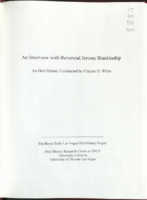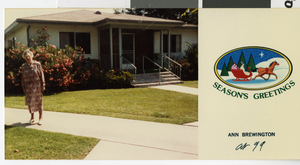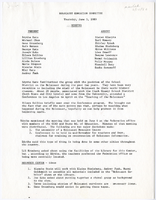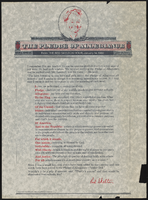Search the Special Collections and Archives Portal
Search Results

Transcript of interview with Allin Chandler by Claytee White, February 5, 2013
Date
Archival Collection
Description
Another member of Rancho High School's first graduating class of 1962, Allin Chandler charted a course that took him from school football to a distinguished career as a teacher, principal, and Executive Director for the Clark County Association of School Administrators. Allin moved to Las Vegas from Texarkana, Texas with his mother in 1958, joining his father who was serving in the Air Force and stationed at Nellis AFB. Starting 9th grade at J.D. Smith Junior High and continuing on to Rancho the following year. Still actively involved in school athletics, Allin quickly discovered his talent and love for maths and science and eventually earned his degree in math and education. The stories Allin shares in this interview paint a vivid picture of how an intelligent and motivated young man can succeed - and how the class-free world of Las Vegas in the 1950s and 60s offered opportunities that he would never have had in class-conscious world of the South.
Text

Gene Noboru Nakanishi oral history interview: transcript
Date
Archival Collection
Description
Oral history interview with Gene Noboru Nakanishi conducted by Ayrton Yamaguchi, Cecilia Winchell, and Stefani Evans on April 2, 2021 for Reflections: The Las Vegas Asian American and Pacific Islander Oral History Project. Gene Nakanishi shares his detailed family history from both his father's and his mother's families. He discusses his paternal grandfather's work on the Union Pacific Railroad, the family's internment in Wyoming during World War II, and his father's release from the camp by joining the United States Army Signal Corps. Nakanishi also talks of his maternal grandfather who was of the Bushido ("warrior") class in Osaka, Japan, and his grandfather's work with Christian missionaries. He shares details of his mother's restaurant employment in Los Angeles and her opening of Osaka Japanese Bistro in Las Vegas in 1969. Nakanishi also talks about being born and raised in Las Vegas, his musical schooling at Berklee College of Music in Boston, and his graduate education at Harvard University. He discusses his work as a band teacher for the Clark County School District, his involvement in the Idyllwild Arts Summer Program band camp, and his interests in jazz music.
Text

Pablo Macias oral history interview: transcript
Date
Archival Collection
Description
Oral history interview with Pablo Macias conducted by Elsa Lopez, Monserrath Hernandez, and Claytee D. White on December 07, 2019 for the Latinx Voices of Southern Nevada Oral History Project. Pablo Macias was rasied in the small town of Carlin outside of Elko, Nevada. His father and mother met in Ogden, Utah where his father was working on railroad in Nevada and Utah. After finishing high school, he got a job at Elko Blacksmith Shop, where he learned to weld. After attending Northern Nevada Community College, he enrolled and graduated from UNR. After graduation, he took a position at Von Tobel Middle School in 1990 teaching Spanish and Physical Education. While working as a Spanish teacher in Rancho High School he enrolled in a Master's program at Nova Southeastern University, completing the program in education administration. He currently serves as the Associate Director of Corporate Work Study Program Operations for Cristo Rey St. Viator College Preparatory High School. Subjects discussed include: Education, Rancho High School, Von Tobel Middle School, Barrick Mining, and Cristo Rey.
Text

Transcript of interview with Reverend Jerome Blankinship by Claytee D. White, November 24, 2004
Date
Archival Collection
Description
Text
Robert Anaya oral history interview
Identifier
Abstract
Oral history interview with Robert Anaya conducted by Beatriz Romero on May 02, 2002 for the Public School Principalship Oral History Project. In this interview, Anaya reflects upon his 30-year career as a teacher and administrator in Texas, prior to working for Nevada’s Clark County School District (CCSD) in the 1990s. He discusses his upbringing and training that led to his becoming a teacher and eventually an administrator, and describes his philosophy of education. He discusses his relationships with school superintendents and the Board of Education as a principal, and his decision to retire and move to Las Vegas, Nevada to work with CCSD.
Archival Collection

Photograph of Ann Brewington, standing in front of her house, 1988
Date
Archival Collection
Description
Image

Holocaust Education Committee letters and meeting minutes, document 12
Description
Holocaust Education Committee meeting minutes on June 05, 1980.
Mike A. Foster oral history interview
Identifier
Abstract
Oral history interview with Mike A. Foster conducted by Heather Christopherson on March 20, 2002 for the Public School Principalship Oral History Project. In this interview, Foster reflects upon his 25-year career as a teacher and administrator with Arizona’s Douglas Unified School District. He discusses the process by which he became an administrator, and describes training and experiences that he feels were most useful for his career. He describes his approach to education, his regular responsibilities, and challenges that he faced as a principal. He also provides his opinion on student ethics and discipline, school overcrowding, teacher evaluations, and dismissals.
Archival Collection
Personal Papers, 1927-2002
Level of Description
Scope and Contents
The Arnold Shaw personal papers (1927-2002) contain correspondence, appointment books, awards, photographs and material from his early days as a teacher. School records, scrapbooks and memorabilia are also included.
Archival Collection
Collection Name: Arnold Shaw Papers
Box/Folder: N/A
Archival Component

